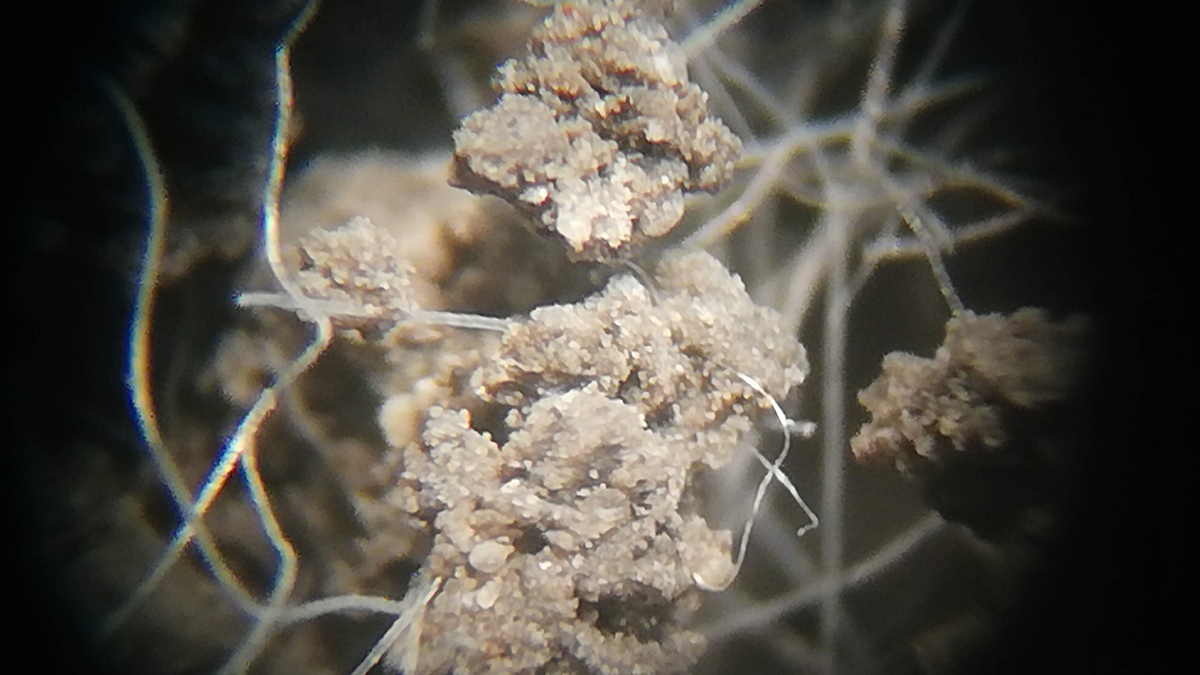As global plastic production has ballooned, small fragments of plastic have infiltrated rivers, sea ice, and even our brains. When the minuscule fibers and shards seep into soils, they change how the soil interacts with water, according to a new study.
The study, published in Vadose Zone Journal, measured water retention and conductivity in soils from three regions of Germany with and without four different microplastics. The researchers found that a plastic concentration of just 0.4% by mass can change how quickly water flows through soil, depending on both the type of plastic and the type of soil. The altered hydraulic properties likely result from the hydrophobic nature of plastic and the microplastic particles changing the arrangement of individual soil granules, the authors said.
Tiny soil particles stick together to form clumps. The spaces between these clumps form conduits for water, nutrients, and plant roots to move through. The size and distribution of these spaces affect soil drainage and water-holding capacity, which have implications for plant growth.
“The water characteristics of a soil tell you how quickly water drains through the soil, which impacts crops and aquifers.”
“The water characteristics of a soil tell you how quickly water drains through the soil, which impacts crops and aquifers,” said the study’s first author, Katharina Neubert, a soil scientist at Forschungszentrum Jülich in Germany.
Earlier research has shown that microplastics can alter soil structure and its hydraulic properties, but those studies each examined only one soil type or one plastic type. The new study is the first to evaluate how multiple types of microplastics affect multiple soil types.
The researchers collected soil from three distinct agricultural regions in Germany, which had varying textures, carbon levels, and pH levels. They then obtained four widely used microplastics ranging in size from 300 micrometers to 5 millimeters—polyethylene, polypropylene, polystyrene, and polyester. They broke down the larger particles in a blender, then mixed each plastic with each soil type at a concentration of 0.4% by weight. Combined with a plastic-free control for each soil type, this yielded 15 unique soil‑microplastic combinations.
The authors poured each mixture into a metal cylinder connected to a suction device to see how quickly the suction would pull water through the soil. They performed the test on wet soil and dry soil, as moisture level also influences how quickly water drains through soil.
Unearthing a Nuanced Relationship
All four microplastics altered water flow rates in at least one of the soils, but the magnitude and direction of the effect varied widely. For example, polyester fibers, commonly shed from some types of clothing, boosted the speed at which water flowed through one soil by more than 50% when the soil was wet, yet reduced the flow rate by more than 50% under dry conditions.
“It’s very difficult to make a general statement about how soil changes with microplastics.”
“All of the results are context dependent,” said Rosolino Ingraffia, a soil scientist at Università degli Studi di Palermo in Italy, who was not involved in the research. “It’s very difficult to make a general statement about how soil changes with microplastics.”
Another recent study coauthored by Neubert showed how differences in flow rates could translate to agriculture. She grew wheat plants in the same three soil types with and without two microplastics: polyethylene and polyester. The results were similarly complicated, with the added plastic increasing, decreasing, or not affecting root growth, depending on the combination.
The plastic concentration of 0.4% used in both studies is much higher than that which most agricultural fields harbor today, said both Neubert and Ingraffia. For example, arable lands that have been treated with biosolids for a decade see concentrations closer to about 0.002%. But calculations based on the current rate of microplastic accumulation suggest that many areas could reach this 0.4% concentration in 50 or 60 years, Ingraffia added.
Neubert hopes her research leads to regulations that keep microplastics from ever reaching those levels. Germany plans to phase out the use of nutrient-rich sewage sludge as fertilizer in most agricultural fields, in part because of concerns about plastic pollution, she said. One study identified the practice as a major source of soil microplastics in Germany.
Keeping plastic out of the ground is important because “we don’t yet know what consequences it has for our soils,” Neubert said.
—Mark DeGraff (@markr4nger.bsky.social), Science Writer

